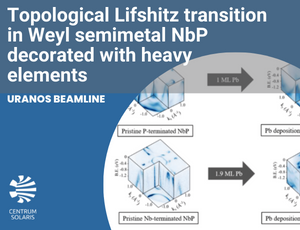
 Web Content Display
Web Content Display
SOLARIS centre
 Web Content Display
Web Content Display
 Web Content Display
Web Content Display
Dramatic Fermi surface modification in niobium phosphide – research on new materials

A team of physicists from the Institute of Physics PAS and SOLARIS Centre has observed a topological Lifshitz transition in the Weyl semimetal NbP by decorating its surface with heavy elements (Pb or Nb). Weyl points in the bulk and Fermi arcs on the surface of Weyl semimetals are the center of interest to material physicists and technology specialists.
Weyl semimetal
Niobium phosphide is an interesting material, representative of the Weyl semimetal family. Weyl semimetals are characterized by the presence of Weyl fermions (which are massless particles with spin 1/2) and Fermi arcs on the surface. Ultra-high mobility of charged Weyl fermions in semimetals may find its applications in electronics and computer science. Research on topological semimetals provides not only physical curiosities but also leads to new electronic materials.
The researchers from the Institute of Physics in Warsaw have grown the single crystals of NbP and characterized their surface properties by using angle-resolved photoemission spectroscopy (ARPES) at URANOS (previous UARPES) beamline at SOLARIS.
Unexpected FS modification
Ashutosh S. Wadge (International Research Centre MagTop, Institute of Physics PAS), the first author of the paper published in Phys. Rev. B , explains the phenomenon in detail as follows:
Niobium monophosphide NbP is a representative example of so-called Weyl semimetals (WSM). These materials have an unusual band structure in which the linearly dispersed valence and conduction bands meet at discrete Weyl points (WP). The other important feature of WSM is surface Fermi arcs (SFAs) that originate from and terminate at the surface projection of a pair of Weyl points of opposite chirality. SFAs are unique open Fermi surfaces (FS) that are unlike closed FS in conventional materials and give rise to many exotic phenomena, such as anomalous quantum oscillations, chiral magnetic effects, 3-dimensional quantum Hall effect, and anomalous electromagnetic wave transmission. Since these intriguing phenomena mainly involve SFAs, hence, from the point of view of basic research and applications, it is very relevant to find an effective way of controlling and modification of SFAs, e.g., of switching them between pairs of Weyl points. We studied surface electronic properties of the P-terminated and Nb-terminated surfaces of NbP with Pb or Nb deposition. An unexpected FS modification has been observed: one monolayer (ML) of Pb influenced the Fermi arcs in such a way that they exchanged the pair of Weyl points and connected the two adjacent Brillouin zones. This change in the Fermi surface is attributed to a topological Lifshitz transition (TLT) with preserved topological characteristics even after surface perturbation. Interestingly, 1.9 ML of Pb on Nb-terminated NbP showed an ordinary Lifshitz transition with no effect on Fermi arcs, 0.8 ML of Nb modified P-terminated Fermi surface with partial TLT.
Link to the publication:
